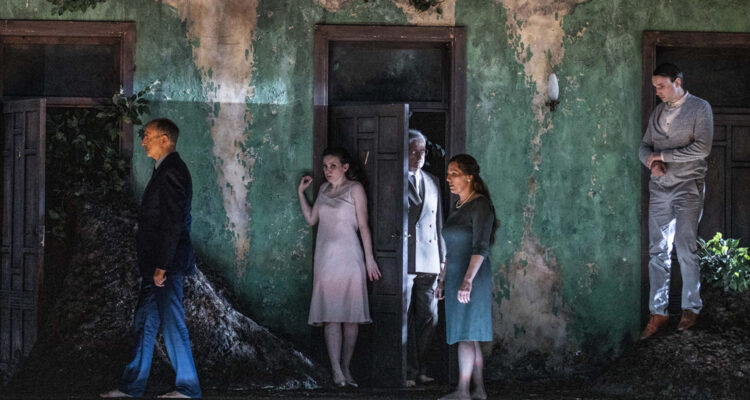Katie Mitchell’s production of Claude Debussy’s Pelléas et Mélisande is an absolute masterpiece. This is a revival of the 2016 production for the Aix-en-Provence Festival, with minor revisions and a different cast and conductor, except for Laurent Naouri, who reprises his original role. It features Mitchell’s trademark stage division into sections, with openings and closings that seamlessly transition the characters from one scene to another. These scenes are visually stunning, with meticulously crafted interiors that, together with the music, render a continuous flow of action, aligning perfectly with Debussy’s intentions.
Pelléas et Mélisande is Debussy’s only opera and is pivotal in the transition from late Romanticism to Modernism in music. The opera’s libretto, based on Maurice Maeterlinck’s play, is imbued with symbolism and ambiguity, focusing on suggestions and allusions rather than a straightforward narrative. It revolves around a classic love triangle where Mélisande is a femme fatale, a mysterious and dangerous woman for all men who approach her. However, according to Katie Mitchell, this is a men’s perspective. Thought-provokingly, Mitchell flips the opera to a woman’s point of view. The opera starts with Mélisande dreaming in her bed. Through the opening and closing sections, we are carried through her dream with Mélisande present in every scene, sometimes as a double, one living the action and one observing (interpreted by a second actress). The result is a complex work with numerous levels of interpretation. But the element that stands out, in my opinion, is the theme of misogyny. This is primarily expressed through Golaud’s physical and psychological abuse of Mélisande, but also through his treatment of Yniold, who in this interpretation is a teenage girl forced to spy on Pelléas and Mélisande in the bedchamber and report back to him. The scenes are very intense, often violent and sexually charged. Arkel, the old blind king, is portrayed as an elderly man openly seduced by Mélisande’s beauty, while Pelléas appears more as an object of desire rather than a seducer.
All the roles are demanding, and the cast measures up splendidly. Laurent Naouri as Golaud is outstanding, interpreting the brutal character with power and conviction. Chiara Skerath, who stepped in at relatively short notice for an indisposed Julia Bullock, handles the demanding role of Mélisande with ease, delivering a clear and expressive performance. Huw Montague Rendall gives moments of intense passion and lyricism in the role of Pelléas. Vincent Le Texier portrays Arkel as an old melancholic man still longing for the freshness of youth, while Emma Fekete is credible as the traumatized Yniold.
Musically, Debussy takes Wagner’s concept of the Gesamtkunstwerk, or “total work of art,” to an extreme, creating seamless, continuous music without traditional breaks between arias and recitatives. Pelléas et Mélisande is characterized by fluid transitions and a continuous musical narrative, although with a more restrained use of leitmotifs. The influence of the French tradition, particularly the works of Jean-Philippe Rameau, is evident in Debussy’s emphasis on elegance, refined orchestration, and vocal lines that often mimic the patterns of spoken French. Conductor Susanna Mälkki and the Orchestre de l’Opéra de Lyon are perfectly aware of these different components. Throughout the performance, they maintain a delicate and constant dialogue with the singers, contributing to the mood, the oneiric atmosphere, and the elusiveness of Debussy’s style.
This production is unmissable.
Grand Théâtre de Provence, Aix-en-Provence, France
Opera
By Claude Debussy
Libretto: François-Louis Gand Le Bland Du Roullet – Nicolas-François Guillard
Conductor: Susanna Mälkki
Director: Katie Mitchell
Cast includes: Laurent Naouri, Chiara Skerath, Huw Montague Rendall, Vincent Le Texier, Emma Fekete, Lucile Richardot, Thomas Dear
Orchestra and choir: Orchestre de l’Opéra de Lyon
Festival d’Aix-en-Provence
Until the 17st of July 2024
Photo credit: Jean-Louis Fernandez

